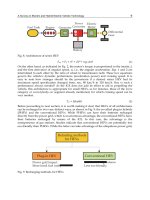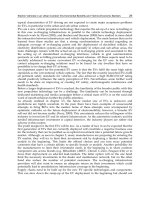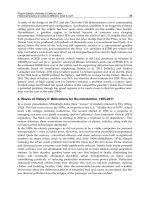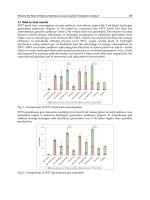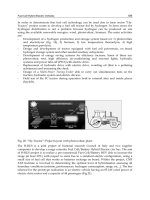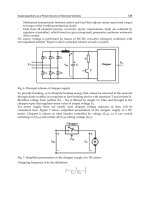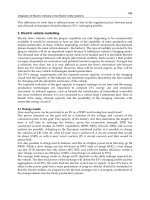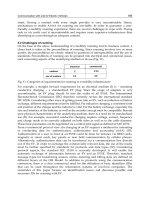Electric Vehicles The Benefits and Barriers Part 9 pptx
Bạn đang xem bản rút gọn của tài liệu. Xem và tải ngay bản đầy đủ của tài liệu tại đây (501.66 KB, 20 trang )
Integration of Electric Vehicles in the Electric Utility Systems
149
This difference in costs that is reflected more or less in the regulated prices between peak
and off-peak consumption should influence EVs’ recharging profiles.
3. Electric vehicle modelling
Electric drive vehicles with the plug-in capability are only beginning to be commercially
available. It would be necessary to have an idea of the capability of mass production and
market penetration of these vehicles depending on their critical components development
phases (namely the most critical element – the battery). The type of mobility provided by the
plug in vehicles will be an important aspect because it influences vehicle´s charging needs.
The demand side of the transportation sector needs to be studied and it is inevitable that the
consumer/passenger behavior will deeply affect future mobility. Each country´s fleet profile
is largely dependent on economical and political/taxation aspects, for instance, Portugal has
a relatively new fleet, but it is very difficult to access the fleet´s renovation rate because
there are few incentives to disposal. However, these will be crucial aspects, as they will be
relevant to the new vehicle technologies market penetration.
The EV’s energy requirements and the expected power capacity in terms of the charging
circuit and the capacity of the batteries are important requisites that define the time needed
for charging and the all-electric autonomy of the vehicle.
The expected evolution of the grid capacity to support recharge at any time and the energy
production technologies are important to compute EVs energy use and emissions
associated. In isolated regions, such as Islands the introduction of intermittent renewable
has more problems because it is not connected to a robust large Continental grid. How to
benefit from using off-peak capacity and the possibility of the charging coincides with
renewable energy sources?
3.1 Energy needs
How much power can be provided to an EV or a PHEV and during how much time?
The power demand on the grid will be a function of the voltage and current of the
connection point to the grid. The capacity of the battery will then determine the length of
time it will take to recharge the battery, given the connection strength. EPRI has
conducted several studies on PHEV capabilities (EPRI, 2002), (Duvall, 2006) and several
options are possible. Adapting to the European mainland reality, it is possible to charge
the vehicles at 230 volts AC with 2,5 mm
2
wire’s section (16 A circuit current) that would
be about 3,5kW or with 4 mm
2
wire’s section (25 A circuit current) and that would be
about 5kW.
It is also possible to charge fast in stations, and this at a higher power level that may go till
50kW. While a slow charge can last 6-8 hours at 100% state of charge (SOC), a fast charge
can last 15-30 minutes but only allows 80% SOC and with less battery efficiency (while a
slow charge can have an efficiency of 80% a fast charge’s is reduced to 55%).
The average daily energy needs to charge an EV depends on the daily mileage expected for
the vehicle. The time and power of the recharge will define the EV’s charging profile and the
aggregation of all EVs, the extra load the electric system has to supply. A few EVs have no
effect in the power grids but a mass penetration of plug-in vehicles should be simulated so
that the electric utilities are prepared with the best strategies for a synergetic combination of
the transportation and electricity production systems.
Electric Vehicles – The Benefits and Barriers
150
3.2 EVs market penetration
There are many factors regarding user preference for electric vehicle technology. The most
pragmatic and objective causes that may a rational potential vehicle buyer decide not to
choose this technology are:
- Fuel availability (the availability of charging infrastructures)
- Range limitations for the BEV configurations
- Acquisition costs
3.2.1 Fuel availability/charging network
PHEVs and BEVs are designed such that they can be plugged into a home garage at night
for fuelling. Garages are most frequently lacking in dense urban areas, the very places
where an electric vehicle is an ideal solution for personal transportation. For example, in
Lisbon only one in six cars are parked in private garages and these include apartment and
condominiums with a parking place with need to plug-in (CML 2002).
In addition to the lack of garage access, the limited electricity-only range of plug-in vehicles
will prompt the desire for drivers to “top off” their batteries when away from their normal
overnight charging location. Electric vehicles must be plugged into the grid to refuel, but a
public infrastructure to provide this service does not yet exist. Prospective plug-in car
owners want the assurance that they can charge their vehicles at home, while at work, or
parked anywhere for extended periods. There is a need for parking/charging points for
slow charge and fast charging stations.
On average, cars are parked roughly 23 hours per day in home garages, apartments,
condominiums and hotel garages, employee parking locations, public lots and curbside. To
meet driver demand for convenient charging, these are the locations in which charging
points should be installed.
3.2.2 Range limitations for BEV configurations
The limited driving range of pure EVs creates what is known as “range anxiety”, which
affect drivers as soon as the battery charge falls below 50%. Fast charging could alleviate
“range anxiety” by supplementing home slow charging with convenient on-road charging
at opportunistic charging points. In one 10-minute charge cycle, fast charge technology can
provide enough energy to allow an EV to operate for another 60 km (Szczepanek A.,
Botsford C., 2009). With a network of fast chargers, consumers could charge anytime,
anywhere – practical infrastructure akin to the gasoline fill-up model. This fast charge
capability can help to enable rapid growth of the EV market by minimizing vehicle
downtime. Fleets can fast charge during opportunistic breaks to maximize productive drive.
Battery manufacturers believe that they could develop a battery that could cope with fast
charging although the priority is to mass produce batteries at low costs, while maintaining
high quality standards, safety requirements and guaranteeing a life time of more than ten
years rather than introducing batteries with super fast charging capabilities.
The successful launch of Li-Ion batteries for electronic goods such as laptops and mobile
phones opened the door to further developments and it may be assumed that Li-Ion
batteries will be the key technology for PHEVs and EVs in the coming decade. Regardless of
the future development in the area of battery based energy storage it can be concluded that
the current level of performance is now so good that the automotive industry has decided to
include partly or fully electrical drivelines and traction batteries in many of their near future
products.
Integration of Electric Vehicles in the Electric Utility Systems
151
When fast charge with safe batteries become available with increased capacity at
competitive prices, the pure BEV can cover a wide range of the transport needs, especially in
urban areas, and be a strong alternative to conventional transport powered by liquid fuels.
The challenge lies in setting up a commercially viable, convenient system for end customers.
The difficulty is how to change drivers’ mobility behavior, so that instead of going to a gas
station just before the tank is empty, drivers need to charge their cars every other time they
park.
There is also a third alternative for recharging EVs, the battery swapping service. This can
be done in recharging stations and the change can be done in about 10 minutes for a full
charged battery. This would relieve “range anxiety” giving the customer three different
modes for recharge:
Slow charge (7/8 hours for 100%);
Fast charge (30 minutes for 80%);
Batteries change (5 minutes for 100%).
The recharge service price should increase as time decreases. A fair price for each of these
recharging models should be established, and this would both be high enough to
infrastructure´s investment recovery and low enough to be advantage to customer. This
service should increase the cost of electricity to recharge.
3.2.3 Acquisition costs
Despite growing environmental awareness in society, studies have repeatedly shown that
customers are only willing to pay a limited price for being “green”. This means that EVs and
PHEVs must be attractively priced, not only in terms of initial purchase price, but also the
ongoing costs each month. The costs of EVs are still much higher than for conventional cars
due to a low production volume and expensive battery packs. This reflects directly the
manufacturing costs. On the other hand, the expenses per travelled km are quite attractive
comparatively to gasoline use, for EV technological solution it is around 1/4. With present
prices pure electric vehicles pay off in terms of cost only if long distances are driven (higher
than 200 000 km) (Baptista, 2009). This fact is important when calculating eventual tax
incentives to purchase these kinds of technologies, having in mind that the final consumer is
extremely sensitive to the “km for breakthrough”. These limitations force Governments
incentives to push the penetration of electric vehicles. There are predictions on the evolution
of EVs’ batteries capacity, density and price for the coming years. According to some
consultancy analysis (Roland Berger, 2008) battery costs are expected to decrease to half the
price from 2010 to 2020.
3.3 EVs recharging profiles
There are many possibilities of vehicles charging profiles. Some could be more likely to
happen but the uncertainty is high as it depends on vehicles charging requirements and
drivers mobility patterns. Many studies performed included different charging scenarios.
3.3.1 Uncontrolled charging
Under this charging profile it is considered that each EV begins charging as soon as it is
plugged in, and stops when the battery is fully charged in case of normal time charge or
80% SOC in case of fast charge. This can be considered a reference case without any
intelligent control of how and when charging occurs, or incentives (such as time-of-use
Electric Vehicles – The Benefits and Barriers
152
rates) to influence individual consumer behavior. The majority of charging is home charging
though a little services charging is also considered. The uncontrollable charge could be as
depicted in Fig. 14.
Fig. 14. Expected charging profile for uncontrolled charging scenario
3.3.2 Off-peak charging
This charging scenario assumes that almost all charging occurs at home in the overnight
hours. Given existing incentives for off-peak energy use it attempts to better optimize the
use of low cost off peak energy by delaying initiation of household charging until 10 pm
(Fig. 15) or 11pm according to the utility policy to promote off-peak demand.
Fig. 15. Expected charging profile for off-peak charging scenario
Under this recharging profile, a peak at 10 pm should be expected in a high EV penetration
scenario. This peak could be smoothed with scheduled strategies for off-peak recharge (Fig.
16).
3.3.3 Optimal charging
This charging scenario also assumes that almost all charging occurs at home during the
off-peak hours, however it attempts to provide the most optimal low cost charging
electricity by assuming that the vehicle charging can be controlled directly by the local
utility. This allows the utility to precisely match the vehicle charging to periods of
minimum demand, allowing the use of lowest cost electricity, and improving overall
utility system performance.
Integration of Electric Vehicles in the Electric Utility Systems
153
Fig. 16. Expected charging profile for a smothing off-peak charging scenario
4. Impacts on primary energy consumption, fossil fuels use, GHG emissions
and electricity costs
The impacts of EVs and PHEVs charge on the electric utilities depend on the first place of
the combination of vehicles’ penetration and charging profile scenarios. The case studies
considered in this chapter arise from the combination of different scenarios of electric
vehicle penetration and recharging operation. For each scenario, the following variables
should be analyzed:
Primary energy needs for the electric and transportation sector working as separate
systems (BAU) and working together (EVs scenarios);
Effects in electricity load profiles.
Impacts on overall energy and CO
2
emissions
Impacts on electricity costs.
Impacts on fossil fuels use and imports.
4.1 Primary energy consumption and fossil fuels use and GHG emissions
Energy consumption, fossil fuels use and CO
2
emissions from electricity production and
transportation (the light duty fleet segment) can suffer great reductions with the integration
of these two sectors by transport electrification. The replacement of a great amount of ICEVs
by EVs in a country in which power generation accounts with more than 50% of renewable
sources has great impacts in fossil fuels use and CO
2
emissions reductions.
In terms of electricity production mix, with plenty renewable sources for generation, two
extreme cases can be considered:
1. A dry year, with high prices offers for hydro and natural gas production, the supply
curves per technology could have the following forms considered a certain power
installed per technology (Fig. 17a).
2. A wet year, with low prices offers for hydro and also natural gas production, the supply
curves per technology could have the forms depicted in Fig. 17b.
The expected load profiles for 2020 in a dry year hypothesis for a 2 million EVs scenario
(about 1/3 of LD fleet replacement) should be as depicted in Fig. 18. A peak effect in load
diagram in an uncontrollable recharge profile can be observed. By transport electrification,
even in the worst situation of uncontrollable recharge, a 2% decrease in primary energy use,
9% in fossil fuels use (due to great reductions in the transportation sector) and 8% in CO
2
emissions can be achieved by transport electrification when compared with the case without
Electric Vehicles – The Benefits and Barriers
154
EVs. An off-peak recharge profile with mass EVs penetration has more effects in energy,
fossil fuels use and emissions reductions. In fact it was verified a 4%, 10% and 9% reduction
respectively.
Fig. 17. Example of supply curves per technology with a) high prices for hydro and natural
gas production; b) low prices for hydro and natural gas production
Fig. 18. Example of the expected Winter demand profile for a dry year 2020 in an EVs’ peak
and off-peak recharge scenario
Fig. 19. Expected Winter spot prices in a peak and off-peak recharge scenarios for 2M EVs in
Portugal mainland
a b
Integration of Electric Vehicles in the Electric Utility Systems
155
In any situation the integration of the electricity generation and transportation sectors has
energy and environmental advantages. The decrease of fossil fuel use brings also economic
advantages in the trading balance as all fossil fuels are imported in this example country.
In terms of the electricity wholesale prices, in a high EV penetration scenario, the leveling of
the spot prices follow the leveling of the load profile (Fig. 19).
It is expectable that the peak effect of uncontrollable charging would cause price sparks at
the peak hours. A time of use price for EVs recharge must be done to avoid this situation.
In the Island example as stated in sections 2.2 and 2.3.1, uncontrollable EVs recharge has
worse consequences in renewable penetration and production prices.
4.2 Electricity costs, the fuel costs for EVs
As stated in section 2.3., electricity costs for EVs’ recharge, either in a market context or as a
vertically owned company is a sum of different costs related to production, net use and
retailing of the product to the final client. To illustrate the differences, we have two case
studies, the mainland, where there is competition in the production and retailing markets
and S. Miguel Island where the same company monopolises all activities.
Adding all the costs associated to electricity supply service, for the mainland case, in a
scenario of low hydro production the price could reach 17 cents/kWh, for 2 Million EVs
charging mainly at peak hours, this includes the whole sale price (8c€/kWh) plus the net
access tariff (the 2010 regulated tariff was used in this example, 9.09c€/kWh) plus the
retailer revenue (a 4% of the wholesale, 0.32c€/kWh). In a high hydro production and low
wholesale prices, an off peak recharge could reach the 5.6 cents/kWh. In these extreme
conditions EV energy prices could be between 0.9€ to 2.8€ per 100 km. Compared with the
most efficient ICEV cars and the present gasoline and Diesel prices in Portugal that can
spend between 4.5€ and 8.2€ per 100 km, there are great advantages in charging EVs during
off-peak hours. These simulations were made considering for the vehicles a slow recharge at
low voltage at home or at service and no extra charge is considered to pay for the
parking/charging service.
For the Island case study, an uncontrollable recharge must be forbidden, as the final
electricity costs would reach the 20 cents/kWh, with all the environmental consequences as
EVs would be recharged mainly with fuel oil. An off-peak recharge could cost only 8
cents/kWh, considered the regulated tariffs imposed (ERSE, 2011). In the Island EVs energy
costs can be between 1.3€ and 3€ per 100 km.
5. Conclusion
Electric vehicles (EVs) and plug-in hybrid electric vehicles (PHEVs), which obtain their fuel
from the grid by charging a battery, are set to be introduced into the mass market and
expected to contribute to oil consumption reduction. PHEVs and EVs can also provide a
good opportunity to reduce CO
2
emissions from transport activities if the electricity they use
to charge their batteries is generated through low carbon technologies. In addition to the
environmental issue, EVs bring techno-economical challenges for utilities as well, because
EVs will have great load flexibility as they are parked 93% of their lifetime, making it easy
for them to charge either at home, at work, or at parking facilities, hence implying that the
time of day in which they charge, can easily vary.
Electric Vehicles – The Benefits and Barriers
156
The replacement of a great amount of ICEVs by EVs in a country in which power
generation accounts with more than 50% of renewable sources has great impacts in fossil
fuels use and CO
2
emissions. The results obtained from the simulations show that, a mass
penetration of electric vehicles in Portugal, contributes to decrease energy consumption,
fossil fuels’ use (mainly oil) and CO
2
emissions from the two sectors (electricity
production and transportation) that nowadays most contribute to the emissions from
fossil fuels burning.
The pressure to generate electricity from endogenous low carbon resources in the majority
of the countries makes naturally transport electrification a solution to lower emissions and
fossil energy use from the transportation sector also. The cost and range of the vehicle
remain the main bottlenecks for EVs penetration.
The cost of the energy to charge the EV is highly dependent on the electricity generation
technologies in the first place, the electricity market structure (whether there is concurrence
or not) and the time of recharge (peak or valley recharge) makes the rest influence on final
costs.
In the examples used in this chapter, scenarios of EV penetration (energy needed) and
recharge profile (hourly power demand) combined with the extreme cases of expected
electricity production lead to different wholesale prices and hourly price profile, as well as
fossil fuels use and emissions associated to charge the EVs, leading to different costs of the
EV fuel per km.
Facing the increasing oil prices, the cost of energy per km of the EVs became even more
advantageous when compared to ICEVs fuel costs and enough to overcome the initial
purchase costs difference.
6. Acknowledgment
Thanks are due to the MIT Portugal Program and Fundação para a Ciência e Tecnologia for
the PhD financial support (SFRH/BD/35191/2007) POS_Conhecimento. The authors would
like to acknowledge FCT- Fundação para a Ciência e Tecnologia through the national project
MMSAFU - Microssimulation Model to Simulate Alternative Fuel Usage
(POCI/ENR/57450/2004), and national project Power demand estimation and power
system impacts resulting of fleet penetration of electric/plug-in vehicles (MIT-Pt/SES-
GI/0008/2008).
7. References
Baptista, P., Camus, C., Silva, C., Farias, T. (2009) Impact Of The Introduction Of Electric
Based Vehicles In São Miguel Island,
10th Conference on Energy for a Clean
Environment,
July 2009
CML Lisbon City Hall, Lisbon (2002): The mobility challenge, 2002, available at
(last accessed
09/05/25)
Denholm, P. and Short, W. (2006), An Evaluation of Utility System Impacts and Benefits of
Optimally Dispatched Plug-In Hybrid Electric Vehicles,
Technical Report NREL/TP-
620-40293, October 2006.
Integration of Electric Vehicles in the Electric Utility Systems
157
Duvall, Dr. Mark S. (2006), “
Plug-in hybrid electric Vehicles Technology Challenges”, EPRI Sep
2006
EDA – Electricity of Azores, available at www.eda.pt
EPRI (2006), Comparing the Benefits and Impacts of Hybrid Electric Vehicle Options for
compact sedan and sport utility vehicles, EPRI,1006892. July 2002
ERSE (2011),
(last accessed 11/01/15)
Hadley, Stanton W. (2006), Impact of Plug-in Hybrid Vehicles on the Electric Grid, October
2006
Hadley, Stanton W. (2008), Potential Impacts of Plug-in Hybrid Vehicles on Regional Power
Generation, ORNL/TM-2008/150, January 2008.
IEA (2007) International energy agency - World Energy Outlook 2007, (pp. 93 assessed
at 09/05/19) at
weo_2007.pdf
IEA (2008) International energy agency - World Energy Outlook 2008. (pp. 508 assessed at
10/10/19) available online at
IEA (2008), Energy Tecnology Perpectives 2008, Chapter 15 Transport
IPCC (2007), “Fourth Assessment Report. Climate Change 2007: Synthesis Report. Summary
for Policy Makers”, 2007.
EVWorld (2009), (last assessed at 20/05/09)
EVreportlinker (2009), (last
assessed 20/05/09)
Kempton,W., Tomic,J., (2005a) Vehicle-to-grid power fundamentals: calculating capacity
and net revenue
, J. Power Sources 144 2005 268-279.
Kempton, W., Tomic, J.,(2005b) Vehicle-to-grid power implementations: from stabilizing
the grid to supporting large-scale renewable energy, J. Power Sources 144 2005
280-294.
Kintner-Meyer Michael, Kevin Schneider, Robert Pratt, (2007) Impacts assessment of
plug-in hybrid vehicles on electric utilities and regional u.s. power grids”, Part
1: technical analysis, Pacific Northwest National Laboratory (a), November,
2007.
OMEL (2009) Electricity Market Operator, available at www.omel.es, assessed at
09/10/10
Parks, K., Denholm, P., Markel,T. (2007), Costs and Emissions Associated with Plug-in
Hybrid Electric Vehicle Charging in the Xcel Energy Colorado Service Territory,
Technical Report NREL/TP-640-41410, May 2007
Roland Berger Strategy Consultants (2008), “Value for EDP in Electric Vehicles, Lisbon, July
29th , 2008
Scott, Michael J., Kintner-Meyer, Michael, Elliott, Douglas B., Warwick, William M. (2007),
Impacts assessment of plug-in hybrid vehicles on electric utilities and regional u.s.
power grids: part 2: economic assessment. Pacific Northwest National Laboratory
(a), November, 2007.
Skea, J.; Anderson, D.; Green, T.; Gross, R.; Heptonstall, P.; Leach, M., (2008)
“Intermittent renewable generation and maintaining power system reliability”,
Generation, Transmission & Distribution, IET Volume 2, Issue 1, January 2008
Page(s):82 – 89
Electric Vehicles – The Benefits and Barriers
158
Szczepanek A., Botsford C., (2009), Electric Vehicle Infrastructure Development: An
Enabler for Electric Vehicle Adoption, EVS24,Stavanger, Norway, May 13-16,
2009
9
Communication with and for Electric Vehicles
Jonas Fluhr and Theo Lutz
Research Institute for Industrial Management (FIR) at the RWTH Aachen University
Germany
1. Introduction
While electric vehicles (EV) are already widespread in particular applications, e.g. fork lifts
or baggage carrying (cf. Rand et al., 1998), their use as individual motor cars is still limited.
E.g., only 2,300 EV were registered in Germany on 1
st
of January 2011 (Federal Motor
Transport Authority, 2011). However, many drivers lead towards an electrification of
individual motor car traffic all over the world: advancing battery technology, high oil prices
in 2008 and 2011, the recent automobile crisis in 2009 and the hope for ecological advantages
of EV usage.
Moreover, the combination of two major energy conversion systems, namely the electric
utility system and the light vehicle fleet (e.g. individual motor cars), could create
considerable synergies (Kempton & Letendre, 1997; Kempton & Tomic, 2005a; Tomic &
Kempton, 2007). One proposed concept is Vehicle-to-Grid realized through “ vehicles with
an electric drive motor powered by batteries, a fuel cell or a hybrid drive train, [that] can
generate or store electricity when parked, and with appropriate connections can feed power
to the grid …” (Kempton & Tomic, 2005b).
EV can be subdivided into hybrid EV (HEV) and battery EV (BEV). The subset of HEV
combines the (parallel or serial) electric drive motor with a combustion engine, a fuel cell or
human power (e.g. Pedelec). The BEV rely only on a – mainly electro-chemical – energy
storage. Although the energy to fulfill an HEV’s mobility function could be provided
alternatively (e.g. by fuel or a battery exchange), all EV are assumed to be plug-in vehicles in
this article. This means they charge from and possibly discharge into the power grid. All in all,
the term EV refers from now on to (at least partly) electrically propelled cars used for
individual motor traffic which can be conductively or inductively connected to the power grid.
A lot of research questions have been raised with respect to EV. Most of them approach the
subject from a technical (e.g. battery performance), economic (e.g. total cost of ownership) or
a user (e.g. driving behaviour) perspective, others investigate social, political and cultural
barriers for broader EV usage (Sovacool & Hirsh, 2009). Information and communication
technology (ICT) (definition cf. Krcmar 2006), is affected in all of these perspectives, since it
has to …
be mastered technically,
be used economically, and
increase usability.
Moreover, research questions can be categorized with respect to an EV’s life cycle which on
a top view corresponds to the serial phases of production, usage and recycling. While
questions about production aim at producing EV efficiently for the market demand, the
Electric Vehicles – The Benefits and Barriers
160
recycling phase refers to economic and ecologic EV elimination. In the usage phase,
questions about the EV in interaction with users and infrastructure are to be answered.
The usage phase will be in focus during the following considerations.The remainder of this
chapter is structured as follows. At first, the closer consideration of the fixed and intersection
point of energy transmission is motivated (section 2). Afterwards, fundamental dimensions for
use cases around the energy transmission are presented and discussed (section 3). The
informational dimension is further detailed to an information system in a separate section
(section 4). Subsequently, the example of e-mobility roaming illustrates why and how the top
view of such an information system is necessary (section 5). Finally, concluding remarks
summarize the status quo and give an outlook on future research (section 6).
2. Fixed and intersection point: energy transmission
The usage of EV brings a major problem into focus: energy. Likewise conventional vehicles,
comfortable and safe mobility can only be guaranteed by a sufficient amount of energy
available in an EV at every point in time. Thereby, “sufficient” depends on the efficiency of
the EV as well as the circumstances of its use. While a small city car can be very efficient and
rarely requires energy for more than 100 km per day, a SUV of a traveling salesman is rather
energy consuming and could need energy for 1000 km or more.
Three fundamental ways of energy transmission are currently discussed for EV: conductive
charging, inductive charging and battery exchange. For one EV, a combination of these general
transmission types is possible, for example normally recharging conductively at home, but
exchanging a battery to realize a rare long trip to visit relatives. Though, such a combination of
different energy transmission technologies clearly comes along with higher costs.
Due to high costs and a low energy density of its storage, especially BEV still have the
disadvantage of a low energy storage capacity (cf. Figure 1, left). Neglecting the technically
more complex battery exchange as well as inductive charging when driving, lifetime
considerations of the (most often) electro-chemical storage requires slow charging and leads
to a rather time-consuming replenishment. In contrast to these disadvantages in comparison
with conventional vehicles, BEV profit from the fact that electricity is already quasi-
omnipresent allowing for many potential suppliers. Conventional vehicles and (to a certain
extent) fuel-based HEV rely on petrol stations operated by only a few companies at well
distributed, but at a limited number of places (compare Figure 1, right).
high
low
high
Capacity
Time to Replenish
BEV
Conventional
Vehicle
F&E
F&E
many
Locations for
Replenishment
few
many
Potential
Suppliers
Fuel
Electricity
Fig. 1. Qualitative comparison of energy storage and availability between BEV and
conventional vehicles
Communication with and for Electric Vehicles
161
To sum up, the discussion at this point reveals that although BEV are unprivileged with
respect to the energy storage, the potential availability of energy is significantly higher.
Therefore, the energy transmission between BEV and the power grid is an important factor of
all BEV applications. Although HEV are not fully reliant on the power grid, the idea of
sustainable mobility by charging renewable energy is realizable only for the charged energy.
Henceforth, all EV business models are forced to define how and when the EV are to be served
with energy. This is why the energy transmission between the power grid and an EV can be
seen as a fixed point of EV usage (cf. Fig. 2), in case of BEV a particular important one.
Fixed and Intersection Point: Energy Transmission
Energy Transmission
Infrastructure
Electric Vehicle
Energy
Fig. 2. Fixed and intersection point of EV business models
The energy transmission is not only a fixed point of EV usage, but also a point of
intersection of different EV business models. For example, an EV manufacturer could
assume the EV buyer to normally charge via a standard power outlet at a standard parking
place (e.g. at home). However, mobility of EV implies that the EV could be anywhere else
other than this standard parking place when the battery runs out of energy. Henceforth, the
EV manufacturer needs to offer the possibility for energy transmission at other than the
standard parking places. The same applies for a car sharing or a car rental company as well
as taxi or delivery services. In all of these examples, an EV can get energy at the standard
parking place most of the time, but occasionally, the EV would rely on foreign energy
transmission infrastructure. Consequently, energy transmission is at the same time a fixed
as well as intersection point of EV usage.
For conventional vehicles, this point of intersection clearly is the petrol station. Independent
of the exact vehicle usage, a conventional vehicle can be refueled through the standardized
filler necks. The petrol stations are not available everywhere, but they are well distributed
over high frequented places. However, this concept works well only for vehicles with a
huge energy storage capacity as well as a fast refueling process. Henceforth, it is improper
for all the EV that need to charge regularly, but can not store huge amounts of energy.
3. Fundamental dimensions for energy transmission use cases
By recognizing the energy transmission as a fixed as well as intersection point of business
models, it becomes apparent that isolated infrastructure is inefficient and renders all business
models unprofitable. Therefore, significant efforts are necessary to standardize the energy
transmission – best on an international level to keep production costs low and allow for e-
mobility roaming (cf. chapter 5). This standardization is currently undergoing in several
working groups of the ISO and IEC in cooperation with national institutes. Fig. 3 gives an
Electric Vehicles – The Benefits and Barriers
162
overview of standards that exist or are currently developed for conductive charging of EV.
With respect to communication between charging infrastructure and EV, the standards
ISO/IEC 15118 (protocol stack for Powerline Communication), IEC 61850-x (adaption of
substation protocols for EV) and IEC 61851-24 (direct current charging) are particularly
relevant.
Safety
Communication
Charging Topology
Plug
IEC 61140
IEC 62040
IEC 60529
IEC 60364-7-722
ISO 6469-3
IEC 62196-1
IEC 62196-2
IEC 62196-3
2
1
3
4
IEC 61851-22
IEC 61851-23
IEC 61851-21
IEC 61851-1
IEC 61851-24
IEC 61850-x
IEC 61851-24
ISO/IEC 15118
IEC 61439-5
IEC 62196-1: Plugs, socket-outlets, vehicle couplers and vehicle inlets Conductive charging of electric vehicles, Charging of electric vehicles up to
250 A a.c. and 400 A d.c.
IEC 62196-2: Plugs, socket-outlets, vehicle connectors and vehicle inlets - Conductive charging of electric vehicles, Dimensional compatibility and
interchangeability requirements for a.c. pin and contact-tube accessories
IEC 62196-3: Plugs, socket-outlets, and vehicle couplers - conductive charging of electric vehicles, Dimensional interchangeability requirements
for pin and contact-tube coupler with rated operating voltage up to 1 000 V d.c. and rated current up to 400 A for dedicated d.c.charging
IEC 61850-x: Communication networks and systems in substations
ISO/IEC 15118: Vehicle to grid communication interface
IEC 61439-5: Low-voltage switchgear and controlgear assemblies, Assemblies for power distribution in public networks
IEC 61851-1: Electric vehicle conductive charging system – General requirements
IEC 61851-21: Electric vehicle conductive charging system – Electric vehicle requirements for conductive connection to an a.c./d.c. supply
IEC 61851-22: Electric vehicle conductive charging system – a.c. electric vehicle charging station
IEC 61851-23: Electric vehicle conductive charging system – D.C electric vehicle charging station
IEC 61851-24: Electric vehicle conductive charging system – Control communication protocol between off-board d.c. charger and electric vehicle
IEC 61140: Protection against electric shock - Common aspects for installation and equipment
IEC 62040: Uninterruptible power systems (UPS)
IEC 60529: Degrees of protection provided by enclosures (IP Code)
IEC 60364-7-722: Low voltage electrical installations, Requirements for special installations or locations - Supply of Electric vehicle
ISO 6469-3: Electrically propelled road vehicles, Safety specification, Protection of persons against electric shock
Fig. 3. Standards for conductive charging of EV (German National Platform for E-Mobility,
2010)
The fixed point of energy transmission can be characterized and designed with respect to
various dimensions. Three fundamental dimensions shall be distinguished in the following:
Electrical (e.g. charger or specification of plug)
Organizational (e.g. parking place type or infrastructure owner)
Informational (e.g. ICT hardware or authentication protocols)
The electrical dimension is the core of energy transmission. That is why international
standardization efforts have focused on this dimension for a long time. Though,
Communication with and for Electric Vehicles
163
organizational and informational aspects become more and more important.
Organizational questions appear with respect to relevant roles and business models (cf.
Fig. 4). Informational aspects are to be investigated since ICT is a promising enabler for
EV usage due to several reasons:
1. Process efficiency for energy supplier and infrastructure operator could be increased.
2. Consumer protection laws require instant, reliable and verifiable information about
transferred energy quantity and corresponding prices for the EV user.
3. The possibility to offer value added services such as the routing to and the reservation
of functioning and free places at the energy transmission infrastructure.
4. More sophisticated concepts such as Vehicle-to-Grid rely on sophisticated real-time
information.
Role Example(s) Organizational Question(s)
User • Social services
• Delivery services
Where, when and how should one’s EV be charged?
How to ensure that the EV are always charged
adequately?
Vehicle
Provider
• Car sharing company
• Car rental company
How to ensure that customers are able to charge where
ever needed in a comfortable manner?
Mobility
Provider
• Taxi What is the charging status of each EV and which EV is
therefore should take which customer?
Energy
Provider
• Energy supplier
• Distribution network
operator
How can a customer be provided with energy in transit?
How is it possible to avoid overcharge a certain grid
string when lots of EV are charging?
Parking Area
Operator
• Supermarket
• Visitor parking area
How to best comfort customers by providing energy for
EV?
Fig. 4. Organizational questions of energy transmission to EV
One could regard the informational dimension linking the electrical and organizational
aspects in order to harmonize the process before, during and after the energy
transmission.
The organizational dimension does not need to include the commercial (financial,
contractual, etc.) aspects, in contrast to the business level identified elsewhere (Bolczek,
2010). Instead, it can be assumed that basic organizational aspects are describable without
assuming certain roles or business models. For example, procedures to access infrastructure
have to be consistent throughout roles and business models and therefore need to be
described independently.
There are abstract use cases that can be characterized around the fixed and intersection
point of energy transmission throughout the three fundamental dimensions. The use cases
themselves can be part of one or several business models.
In each dimension, a number of attributes can be identified while an attribute can be
instantiated by one or several values. This can be seen as a simple morphological box (cf.
Zwicky & Wilson, 1967). The combination of values over attributes and dimensions leads to
a particular use case. Many and manifold use cases are possible, however, only a few
particular types will fit to the requirements of business models in the long run. An excerpt
of such a box is given in Fig. 5.
Electric Vehicles – The Benefits and Barriers
164
Dimension Attribute Value(s)
Electrical
Energy
Transmission
Conductive Inductive Battery Exchange
Plug Specification CEE 7/7 CEE 3P+
N+PE, 6h
JARI Level
3 DC
IEC 62196-2 SAE J1772 SCAME
Organizational
Entitled to dispose
of infrastructure
Natural Person
(private: individual)
Legal Person
(private: company)
Legal Person
(public: authority)
Access Level EV parking place EV supply equipment Electricity
Informational
Top Level
Elements
User EV EV Supply
Equipment
IT-Backend
Authentication
Hardware
RFID SmartCard Mobile Phone
(SimCard)
Fig. 5. Excerpt of attributes in the morphological box in three dimensions
With respect to the communication with and for EV, the informational dimension is
pertinent and will be focused on in the following.
4. Information system for electric vehicles
The informational dimension can be described via an information system. An information
system is a social and technical system that combines human and mechanical components to
achieve the optimal allocation of information and communication (cf. Heinrich, 2005;
Krcmar, 2007). The description of such an information system is the base to design an
adequate information flow within and throughout the manifold business models. As seen
before, the point of energy transmission is a fixed point for all EV. Henceforth, this fixed
point is a useful starting point for the description of an information system for EV usage.
Top level elements of such an information system are elements that play a prominent role
when it comes to using or processing information. Those elements were identified to be the
user of the EV, the EV itself, the point of energy transmission, as well as the supporting IT-
Backend (cf. Fig. 6). Deliberately, the IT-Backend resembles a cloud, since – with some ups
and downs – there is a continuous trend towards the flexible utilisation of IT-Infrastructure
and services over (high speed) internet connections.
An information system can be detailed via an information system architecture. Several
information system architectures have been proposed (The Open Group Architecture
Framework, 2010; Scheer, 2000; Krcmar 2007). However, on the top level the architecture
components are very similar and the architectures differ mainly with respect to their
illustration. Although, the information system architecture concepts were originally
developed for enterprises to describe and design their information system, it can be adapted
to fit the needs for an information system around EV usage.
According to Krcmar (2007), an information system architecture consists of six components,
namely
Infrastructure
Communication with and for Electric Vehicles
165
Communication architecture
Data architecture
Application architecture
Organizational architecture
Strategy
Information System
Information
Process
Point of Energy
Transmission
IT-BackendElectric VehicleUser
Energy
Fig. 6. Top level elements of the information system for EV
The components are structured hierarchically, from rather physical ones (infrastructure) to
rather logical ones (strategy). In order to emphasize that these components must be well
balanced to achieve efficient information flows, Krcmar used the spinner to illustrate the
relations of the components (cf. Fig. 7).
Application architecture
Data
architecture
Infrastructure
Strategy
Organizational
architecture
Depending on
business models
Independent from
business models
Communication
architecture
Not part of the
informational dimension
Fig. 7. Information system architecture as spinner (adapted from: Krcmar, 2006)
The architecture originally was designed for enterprises which realize at least one business
model. Thus, the creation of use case types independent of business models requires an
adaption of the general architecture. At first, due to the close relation to long term profit, the
strategy has to be left out. Secondly, the organizational architecture that stands for a
Electric Vehicles – The Benefits and Barriers
166
company’s process and structural organization is not part of the information dimension (cf.
section 3). Well adapted for a base for use case types are the infrastructure, the data
architecture, the communication architecture as well as the application architecture. They
can be characterized as follows:
The infrastructure contains all design elements of ICT hardware, for example which
kind of microcontroller, CPU, graphics card, etc. are used.
The data architecture consists of data models and objects that are necessary to provide
information to EV users and other stakeholders.
The communication architecture describes the topology for communication as well as
the used protocols.
The application architecture is built up on the first three components in order to
provide defined functions for users and systems.
However, these components of an information system can hardly be interpreted in an
isolated manner, but are in close relation and interaction. Thus, despite the focus on the
communication architecture, the remainder of this chapter will also contain aspects of
infrastructure, data and functions.
With respect to the communication with and for EV, it is useful to adapt the general
information system overview (Fig. 6) and explicitly model the most important IT-Systems
(Fig. 8). In addition to the EV, a mobile device as well as a fixed device is available for an EV
user. A device shall be considered “mobile” in this context when an EV user can handle it
comfortably in an upright position. For the following examples, the abstract level of energy
transmission is left and conductive charging is assumed:
An example for a mobile device is a mobile phone that can be used to unlock a charging
station via a hotline call or a SMS. Alternatively, the widespread smartphones are able
to unlock the charging station via an application (“App”) offered by the energy supplier
of the EV user.
An example for a fixed device is a desktop personal computer or a notebook. Via a
client application or a website, they allow for an offline check of the individual charging
behaviour (e.g. place, energy and cost).
Fig. 8. Communication architecture from an EV user perspective
Communication with and for Electric Vehicles
167
This adapted view of the information system is the infrastructural base of communication
from the EV user perspective. In this chapter, the server landscape in the IT-Backend is not
further detailed. Although, design and operation of applications and services in the IT-
Backend is challenging, the questions that are to be asked and answered are not necessarily
specific for e-mobility. In many cases, the integration of e-mobility in existing software
solutions is the core problem. This is done via interfaces of which four already appear in the
chosen illustration (Fig. 8).
After this introduction to the information system at the fixed point of energy transmission to
and from an EV, an example shall illustrate how this information system view can help to
master the current informational challenges of EV usage. Interesting examples would be:
1. Access to own infrastructure under consideration of authentication, authorisation and
accounting.
2. Access to foreign infrastructure under consideration of authentication, authorization
and accounting.
3. Collection and transmission of metering data with respect to the conflicting goals of
usage transparency, data reliability and data privacy.
4. Value added user services such as routing to or reservation of infrastructure.
5. Vehicle-to-Grid services such as frequency regulation.
Since Vehicle-to-Grid services and value added user services are not solving one core
problem of e-mobility (“enough energy for mobility”), they might be less interesting at this
point. For a discussion of the collection and transmission of metering data, the different
national laws play an important role. However, access to infrastructure is a prior subject in
all countries, and when using foreign infrastructure an informational interesting one.
Therefore, the following chapters use this subject, later defined more precisely as e-mobility
roaming, to illustrate the information system in detail. For the sake of convenience, again the
conductive charging is assumed. For inductive charging or battery exchange, similar
considerations can be made.
5. E-mobility and roaming
5.1 Motivation
Considering private car owners, they can be distinguished by the type of their standard
parking place (e.g. at home). Either car owners have a dedicated parking space such as a
garage, or they park curbside somewhere nearby. The former can charge the EV by simply
plugging it into a fixed socket-outlet in their garage. In this case, no identification and
authorization is needed – however possibly useful in the future for providing grid services
(Vehicle-to-Grid). While charging at the standard parking space can cover most trips,
recharging is necessary from time to time if the trip distance is higher than a typical EV-
range or recharging at the standard parking space is not possible. Hence, in such cases, these
EV owners rely on foreign charging infrastructure for which physical access, authentication,
authorization and accounting (AAAA) is needed. The latter group, i.e. EV owners parking
curbside, need foreign charging infrastructure every day.
Carsharing companies can have dedicated parking spaces for their cars. For EV usage, they
can upgrade them with electric vehicle supply equipment (EVSE). Thus, whenever an EV is
parked there, it can be recharged by using individual methods for AAAA. Since many
carsharing offers still restrict the start and end of any rental to these dedicated parking
spaces, regular recharging is guaranteed. However, for two reasons this is not enough: First
Electric Vehicles – The Benefits and Barriers
168
of all, in some cases, the user might need to additionally recharge somewhere else. Secondly,
the product “carsharing” mainly sells easy access to individual mobility. Therefore, the most
successful carsharing companies will allow the start and end of a rental anywhere which
endangers regular recharging at the dedicated parking spaces. A carsharing company can
enable recharging not only at those own dedicated parking spaces, but also at foreign
charging infrastructure by guaranteeing AAAA there.
DefinitionTerm
Operates at least one EVSE as a service for E-Mobility Providers,
but has no continuous contractual relation to EV Users.
EVSE
Operator
Uses an EV within a contract with an E-Mobility Provider.EV User
Contracts with EV Users in order to offer services (e.g. charging) and
can be EVSE Operator at the same time.
E-Mobility
Provider
DefinitionTerm
Operates at least one EVSE as a service for E-Mobility Providers,
but has no continuous contractual relation to EV Users.
EVSE
Operator
Uses an EV within a contract with an E-Mobility Provider.EV User
Contracts with EV Users in order to offer services (e.g. charging) and
can be EVSE Operator at the same time.
E-Mobility
Provider
Fig. 9. Terms to define e-mobility roaming
All in all, these two simple and known business models already show that the usage of
foreign charging infrastructure would occur regularly. This is often referred to as e-mobility
roaming, in analogy to the mobile communications sector. More precisely, roaming with
cellular phones means the uninterrupted availability of all services while moving out of
range of the former carrier to another one (Schiller, 2003). On this base as well as with the
definitions in Fig. 9, e-mobility roaming (or just roaming) in this paper refers to the situation
in which an EV User is using an EVSE within a contract with an E-Mobility Provider that is
not the EVSE Operator of the used EVSE (cf. Fig. 10).
E-Mobility
Provider
EV User
EVSE Operator
Roaming
Agreement
Roaming
User
contract
EVSE
Fig. 10. E-mobility roaming
Due to the still prevailing regional and local character of many power markets (e.g. in
Germany), roaming is likely to happen not only international, but even within one town or

